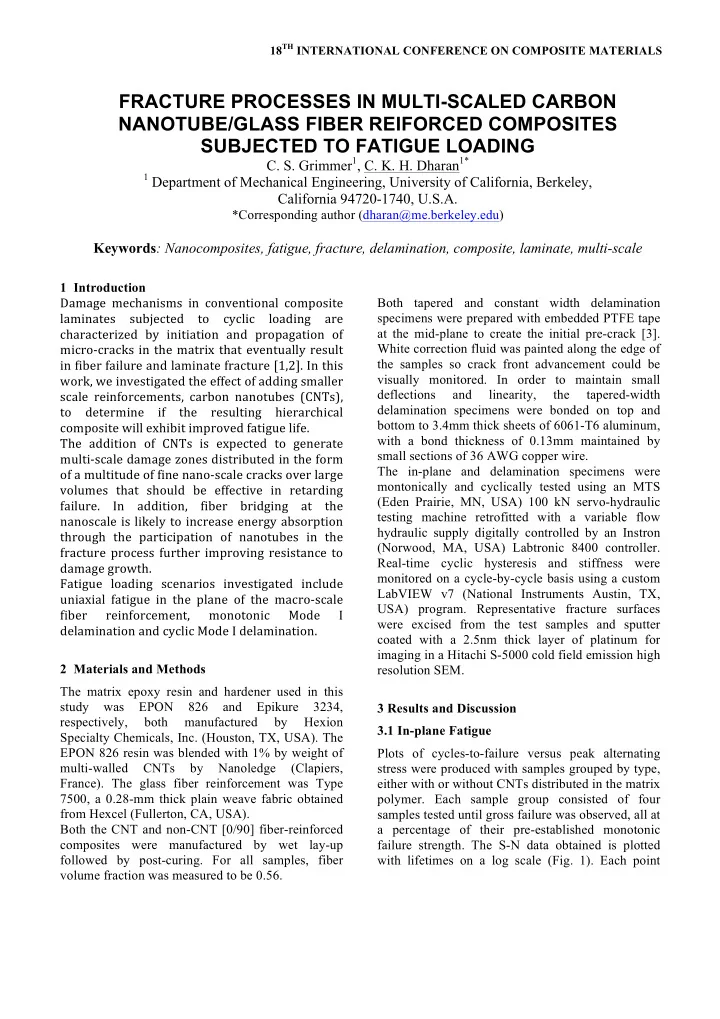

18 TH INTERNATIONAL CONFERENCE ON COMPOSITE MATERIALS FRACTURE PROCESSES IN MULTI-SCALED CARBON NANOTUBE/GLASS FIBER REIFORCED COMPOSITES SUBJECTED TO FATIGUE LOADING C. S. Grimmer 1 , C. K. H. Dharan 1* 1 Department of Mechanical Engineering, University of California, Berkeley, California 94720-1740, U.S.A. *Corresponding author (dharan@me.berkeley.edu) Keywords : Nanocomposites, fatigue, fracture, delamination, composite, laminate, multi-scale 1 Introduction Damage ¡ mechanisms ¡ in ¡ conventional ¡ composite ¡ Both tapered and constant width delamination laminates ¡ subjected ¡ to ¡ cyclic ¡ loading ¡ are ¡ specimens were prepared with embedded PTFE tape characterized ¡ by ¡ initiation ¡ and ¡ propagation ¡ of ¡ at the mid-plane to create the initial pre-crack [3]. White correction fluid was painted along the edge of micro-‑cracks ¡in ¡the ¡matrix ¡that ¡eventually ¡result ¡ the samples so crack front advancement could be in ¡fiber ¡failure ¡and ¡laminate ¡fracture ¡[1,2]. ¡In ¡this ¡ visually monitored. In order to maintain small work, ¡we ¡investigated ¡the ¡effect ¡of ¡adding ¡smaller ¡ deflections and linearity, the tapered-width scale ¡ reinforcements, ¡ carbon ¡ nanotubes ¡ (CNTs), ¡ delamination specimens were bonded on top and to ¡ determine ¡ if ¡ the ¡ resulting ¡ hierarchical ¡ bottom to 3.4mm thick sheets of 6061-T6 aluminum, composite ¡will ¡exhibit ¡improved ¡fatigue ¡life. ¡ ¡ with a bond thickness of 0.13mm maintained by The ¡ addition ¡ of ¡ CNTs ¡ is ¡ expected ¡ to ¡ generate ¡ small sections of 36 AWG copper wire. multi-‑scale ¡damage ¡zones ¡distributed ¡in ¡the ¡form ¡ The in-plane and delamination specimens were of ¡a ¡multitude ¡of ¡fine ¡nano-‑scale ¡cracks ¡over ¡large ¡ montonically and cyclically tested using an MTS volumes ¡ that ¡ should ¡ be ¡ effective ¡ in ¡ retarding ¡ (Eden Prairie, MN, USA) 100 kN servo-hydraulic failure. ¡ In ¡ addition, ¡ fiber ¡ bridging ¡ at ¡ the ¡ testing machine retrofitted with a variable flow nanoscale ¡is ¡likely ¡to ¡increase ¡energy ¡absorption ¡ hydraulic supply digitally controlled by an Instron through ¡ the ¡ participation ¡ of ¡ nanotubes ¡ in ¡ the ¡ (Norwood, MA, USA) Labtronic 8400 controller. fracture ¡process ¡further ¡improving ¡resistance ¡to ¡ Real-time cyclic hysteresis and stiffness were damage ¡growth. ¡ ¡ monitored on a cycle-by-cycle basis using a custom Fatigue ¡ loading ¡ scenarios ¡ investigated ¡ include ¡ LabVIEW v7 (National Instruments Austin, TX, uniaxial ¡ fatigue ¡ in ¡ the ¡ plane ¡ of ¡ the ¡ macro-‑scale ¡ USA) program. Representative fracture surfaces fiber ¡ reinforcement, ¡ monotonic ¡ Mode ¡ I ¡ were excised from the test samples and sputter delamination ¡and ¡cyclic ¡Mode ¡I ¡delamination. ¡ coated with a 2.5nm thick layer of platinum for ¡ imaging in a Hitachi S-5000 cold field emission high 2 Materials and Methods resolution SEM. The matrix epoxy resin and hardener used in this study was EPON 826 and Epikure 3234, 3 Results and Discussion respectively, both manufactured by Hexion 3.1 In-plane Fatigue Specialty Chemicals, Inc. (Houston, TX, USA). The EPON 826 resin was blended with 1% by weight of Plots of cycles-to-failure versus peak alternating multi-walled CNTs by Nanoledge (Clapiers, stress were produced with samples grouped by type, France). The glass fiber reinforcement was Type either with or without CNTs distributed in the matrix 7500, a 0.28-mm thick plain weave fabric obtained polymer. Each sample group consisted of four from Hexcel (Fullerton, CA, USA). samples tested until gross failure was observed, all at Both the CNT and non-CNT [0/90] fiber-reinforced a percentage of their pre-established monotonic composites were manufactured by wet lay-up failure strength. The S-N data obtained is plotted followed by post-curing. For all samples, fiber with lifetimes on a log scale (Fig. 1). Each point volume fraction was measured to be 0.56.
represents the average and standard deviation of the four samples tested. Fig. 1. Applied cyclic stress v. number of cycles to Fig. 2. Representative load-displacement loops used failure (in-plane cyclic loading) for determination of G IC . 3.2 Mode I Delamination 3.3 Cyclic Mode I Delamination The tapered width delamination samples facilitated Measurements of G IC , the critical strain energy release rate, were obtained from plots of the load- the stable measurement of crack propagation at sub- displacement profile for each of the delamination critical cyclic strain energy release rates. These measurements are then used to produce plots of load-unload tests conducted on the constant width samples (Fig. 2). The energy for crack advancement crack advancement versus cyclic stain energy is obtained from the area inside the curve for a release rate. Analysis of these plots provides the constants, C and m from the power law equation, single load-unload cycle that is normalized by the da/dN = C Δ a m (Fig. 3). area of the new crack surface created, i.e., (1) Here, P is the applied load, δ is the grip displacement, w is the sample width and Δ a is the incremental change in the crack length [4]. The measured mean and standard deviation of G IC for the conventional and hybrid composites respectively were 790 (18.1) J/m 2 and 816 (23.3) J/m 2 . The results were averaged over ten tests conducted on two samples for both the conventional and hybrid composites. Due to the relatively blunt nature of the Fig.3. Delamination cyclic crack growth per cycle v. PTFE pre-crack and the resulting inflation in the applied cyclic strain energy release rate. C and m are measured G IC , the data from the initial pop-in cycle fitted parameters in the equation: da/dN = C( Δ G) m . was discarded. Representative load-displacement loops are shown for a typical test in Fig. 2. A significant increase in the number of cycles-to- failure for each loading case was observed for the samples that contained the CNT-blended resin. The
Recommend
More recommend